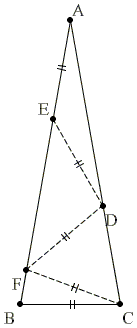The 80-80-20 Triangle Problem, A Derivative, Solution #6

ABC is an isosceles triangle with vertex angle
|Contact| |Front page| |Contents| |Geometry| |Up|
Copyright © 1996-2018 Alexander Bogomolny
This solution has been reported in [Leikin].
The proof is practically by construction.

Starting from BC, form a sequence of isosceles triangles, BCF, CFD, FDE, DEA. Is it possible? Let us check the angles.
For ΔBCF to be isosceles, suffice it to pick ∠BCF = 20°, for then
If point D on AC is such that DF = FC (and such point exists!), then, since
If E' on AB (not shown) is such that DF = DE' (and such a point exists), then ΔFDE' is isosceles,
It follows that ∠ADE' = 20° = ∠DAE'. Therefore, ΔADE' is isosceles and
Since ΔCFD is equilateral, CD = BC = DE, so that ΔCDE is also equilateral with
Reference
|Contact| |Front page| |Contents| |Geometry| |Up|
Copyright © 1996-2018 Alexander Bogomolny
73549651
